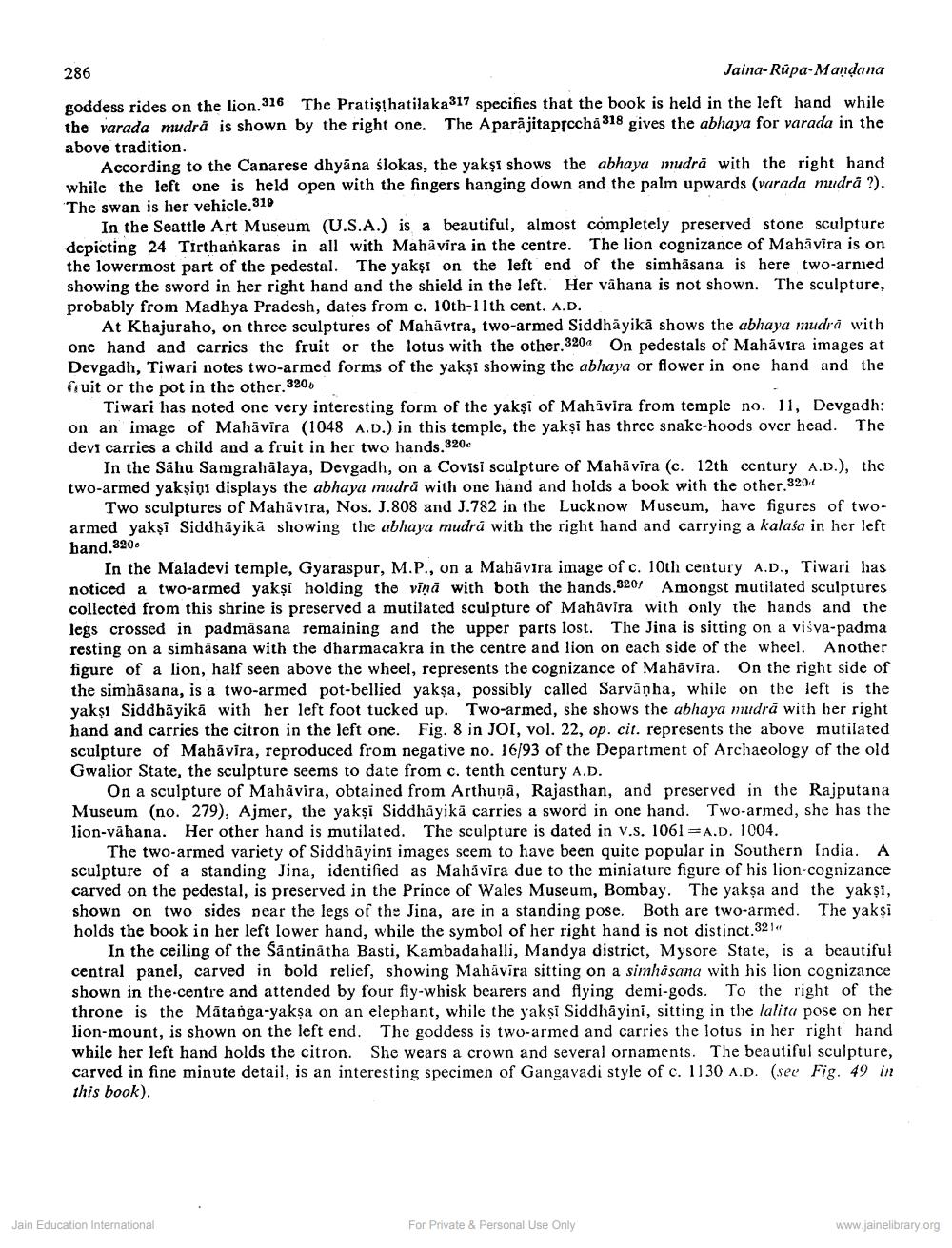________________
286
Jaina-Rupa-Mandana goddess rides on the lion.316 The Pratishatilaka 317 specifies that the book is held in the left hand while the varada mudra is shown by the right one. The Aparajitaprocha 318 gives the abhaya for varada in the above tradition.
According to the Canarese dhyāna ślokas, the yakşi shows the abhaya mudra with the right hand while the left one is held open with the fingers hanging down and the palm upwards (varada muudrå ?). The swan is her vehicle. 319
In the Seattle Art Museum (U.S.A.) is a beautiful, almost completely preserved stone sculpture depicting 24 Tirthankaras in all with Mahavira in the centre. The lion cognizance of Mahavira is on the lowermost part of the pedestal. The yakşi on the left end of the simhäsana is here two-arnied showing the sword in her right hand and the shield in the left. Her vahana is not shown. The sculpture, probably from Madhya Pradesh, dates from c. 10th-11th cent. A.D.
At Khajuraho, on three sculptures of Mahāvíra, two-armed Siddhāyikā shows the abhaya mudra with one hand and carries the fruit or the lotus with the other. 320. On pedestals of Mahavira images at Devgadh, Tiwari notes two-armed forms of the yakşi showing the abhaya or flower in one hand and the fruit or the pot in the other. 320)
Tiwari has noted one very interesting form of the yakşi of Mahivira from temple no. 11, Devgadh: on an image of Mahāvira (1048 A.D.) in this temple, the yakși has three snake-hoods over head. The devi carries a child and a fruit in her two hands 3200
In the Sāhu Samgrahālaya, Devgadh, on a Covisi sculpture of Mahāvīra (c. 12th century A.D.), the two-armed yaksini displays the abhaya mudrā with one hand and holds a book with the other.3204
Two sculptures of Mahāvira, Nos. J.808 and J.782 in the Lucknow Museum, have figures of twoarmed yakşi Siddhãyika showing the abhaya mudrá with the right hand and carrying a kalasa in her left hand.3206
In the Maladevi temple, Gyaraspur, M.P., on a Mahāvira image of c. 10th century A.D., Tiwari has noticed a two-armed yakşi holding the vinä with both the hands.320/ Amongst mutilated sculptures collected from this shrine is preserved a mutilated sculpture of Mahāvīra with only the hands and the legs crossed in padmāsana remaining and the upper parts lost. The Jina is sitting on a visva-padma resting on a simhasana with the dharmacakra in the centre and lion on each side of the wheel. Another figure of a lion, half seen above the wheel, represents the cognizance of Mahāvira. On the right side of the simhasana, is a two-armed pot-bellied yakşa, possibly called Sarvāṇha, while on the left is the yakşi Siddhāyikā with her left foot tucked up. Two-armed, she shows the abhaya mudra with her right hand and carries the citron in the left one. Fig. 8 in JOI, vol. 22, op. cit. represents the above mutilated sculpture of Mahavira, reproduced from negative no. 16/93 of the Department of Archaeology of the old Gwalior State, the sculpture seems to date from c. tenth century A.D.
On a sculpture of Mahāvira, obtained from Arthunā, Rajasthan, and preserved in the Rajputana Museum (no. 279), Ajmer, the yakşi Siddhāyikā carries a sword in one hand. Two-armed, she has the lion-vāhana. Her other hand is mutilated. The sculpture is dated in v.s. 1061 = A.D. 1004.
The two-armed variety of Siddhāyini images seem to have been quite popular in Southern India. A sculpture of a standing Jina, identified as Mahavira due to the miniature figure of his lion-cognizance carved on the pedestal, is preserved in the Prince of Wales Museum, Bombay. The yakșa and the yakşi, shown on two sides near the legs of the Jina, are in a standing pose. Both are two-armed. The yakşi holds the book in her left lower hand, while the symbol of her right hand is not distinct.3214
In the ceiling of the Santinātha Basti, Kambada halli, Mandya district, Mysore State, is a beautiful central panel, carved in bold relief, showing Mahāvīra sitting on a simhasana with his lion cognizance shown in the centre and attended by four fiy-whisk bearers and flying demi-gods. To the right of the throne is the Mātanga-yaksa on an elephant, while the yakşi Siddhāyini, sitting in the lalita pose on her lion-mount, is shown on the left end. The goddess is two-armed and carries the lotus in her right hand while her left hand holds the citron. She wears a crown and several ornaments. The beautiful sculpture, carved in fine minute detail, is an interesting specimen of Gangavadi style of c. 1130 A.D. (see Fig. 49 in this book).
Jain Education International
For Private & Personal Use Only
www.jainelibrary.org




